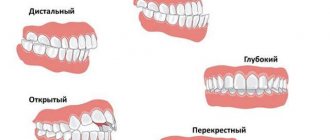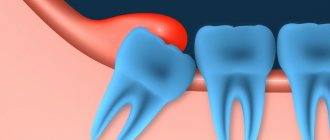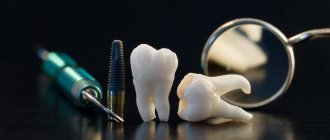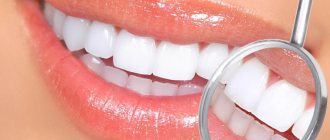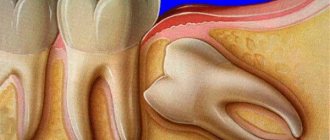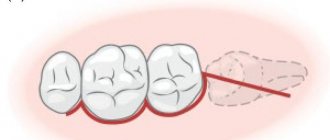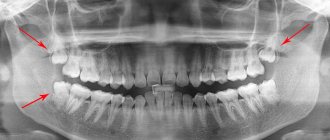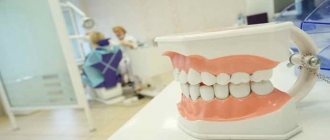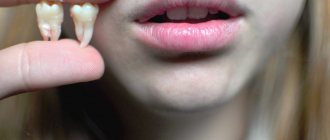Wisdom tooth dystopia is an abnormal position of the tooth in a row or its movement beyond the alveolar process of the jaw (the part on which the teeth are located). This disease can negatively affect the bite, and also lead to permanent (chronic) injuries to the oral mucosa and the development of oral diseases that require serious treatment. This anomaly is common: about 70% of people suffer from dystopia. It is often observed in a situation with a wisdom tooth, because it could initially have been laid at an angle and come out in this position to the dentition. To avoid the appearance of unpleasant symptoms, you need to control the growth state of the figure eight.
What to do if a wisdom tooth grows horizontally - correct it or remove it?
The wisdom tooth (eight or third molar) is the farthest element in the row, which appears later than all the others, and in some cases remains in the gum. Its internal structure is distinguished by a complex, often branched and tangled root system. In addition, this is the most problematic tooth, since most often it is initially in the wrong position, grows in a horizontal direction and thereby creates a lot of inconvenience, and also provokes serious complications. Today we’ll talk about the causes and consequences of the horizontal position of the wisdom tooth, as well as what to do in such a difficult situation.
Causes of dystopia
REFERENCE Dystopia is an incorrect position in the dentition or movement beyond the edge of the alveolar process of the jaw.
During the intrauterine development of a child, data about the jaw model is laid down. First, the incisors, canines, premolars and other molars appear, and only then the eights erupt, which otherwise do not have enough space. The body directs tooth growth to where there is free space. This is the main reason for the horizontal position of the molar, but there are a number of others :
- Atavism, in which the erupting extra teeth occupy the free area of the gums intended for eights.
- Malocclusion due to jaw fracture.
- Eruption of permanent teeth in a chaotic manner due to the loss of baby teeth ahead of schedule.
- Lack of guidance for the eruption of wisdom teeth.
Why do eights almost always grow incorrectly?
The rudiments of wisdom teeth form in all people, but they do not always erupt completely, and may not appear above the gum at all. They begin to grow last, at about 25 years of age. The problem is that eights are rudiments that we inherited from our ancestors. In ancient times, when people had to eat raw meat, their jaw system was much larger, and the wisdom teeth in it performed the function of thoroughly crushing solid food.
Evolution has greatly changed our appearance, and the jaw arches have noticeably decreased in size over time. Therefore, there is simply not enough space left for the eights, and this is one of the main reasons why in most cases they lie horizontally and grow in the wrong position. As a result, excessive pressure is exerted on neighboring elements, which leads to deformation of the entire row.
Third molars grow very slowly and often remain half under the gum - this phenomenon is called retention. When an impacted wisdom tooth is also in a horizontal position, experts diagnose it as dystopia. All this usually leads to the development of inflammatory processes in the mucous membrane and rapid destruction of dental tissues by caries.
Germination into an adjacent tooth: what is dangerous?
First, it’s worth examining the concept of retention. This is incomplete tooth eruption. It is directly related to dystopia. The impacted tooth is covered with gum and cannot grow upward, moving even more towards the adjacent crown. This combination causes not only problems with bite, but also constant inflammatory processes in the gums above the crown, which is defined as pericoronitis.
Possible consequences when the figure eight grows horizontally:
- destruction of the tooth enamel of the tooth into which the figure eight rests;
- the occurrence of crowding when the teeth are out of place;
- increased risk of tumor formation as a result of constant trauma to the mucous membrane;
- difficulty opening the mouth;
- damage to the gums, which leads to pericoronitis, periostitis, periodontitis;
- the occurrence of infection, which causes the temperature to rise and general health to worsen.
We suggest you read: Is it possible to pull out wisdom teeth?
How to determine that a wisdom tooth is “lying on its side” - symptoms
Dental experts identify several sure signs that the figure eight is growing horizontally. Here are the main symptoms:
- constant aching pain in the specified area,
- development of inflammatory processes, often with the release of pus,
- a feeling of discomfort when opening the mouth and chewing food,
- heavy bleeding
- row curvature,
- temperature increase,
- the formation of a gingival hood in the place where the tooth should appear.
If the tooth grows incorrectly, inflammation and gum hood may form.
If the above symptoms appear, you should immediately consult a dentist. The sooner you visit a doctor, the lower your risk of complications.
If you do not remove the dystopic figure eight, there is a danger of complications
If the third molar grows at an angle, it poses a threat to the health of other teeth, so this situation requires timely medical intervention. It also creates a constant traumatic effect on the mucous membrane, which can soon provoke inflammation. If you continue to ignore the symptoms, it can lead to even more serious problems:
- purulent lesions - an open wound appears at the site of eruption, and if pathogenic microorganisms get into it, this can lead to inflammation and purulent processes. As a result, there will be a risk of developing periodontitis, abscesses and even osteomyelitis,
- bleeding - if the tooth lies deep enough and horizontally, then during its growth the vessels will be injured, which can easily provoke serious bleeding,
- curvature of the bite - figure eights displace their “neighbors”, which soon leads to deformation of the occlusion as a whole,
- There are numerous abrasions and scratches on the mucous membrane - the result of constant injury to soft tissues and a direct prerequisite for infection.
Horizontal tooth growth brings many complications.
One of the most severe complications is the development of oncology. This happens very rarely, but experts still do not exclude the possibility of this sad scenario developing. The risk in this case is due to the constant traumatic effect on the cheek from the inside, which in the future can lead to dangerous structural changes in the mucosa and the appearance of malignant neoplasms.
Indications for surgery
The very presence of a dystopic molar will already be an indication for removal. However, there are conditions in which surgery is required. In other cases, non-surgical treatment can be performed. The latter option does not guarantee that the tooth will not be disturbed in the future.
The dentist cannot say with certainty that treatment without extraction will be successful, so he always recommends extraction. Practice shows that the longer you delay removal, the more difficult it is to carry out later. The problem slowly but surely gets worse, even if there is no discomfort. Some anomalies develop asymptomatically.
Absolute indications for removal of a dystopic third molar:
- development of caries, periodontitis, pulpitis, when therapeutic treatment is impossible;
- retention with regular inflammation of the hood above the crown;
- permanent injury to the buccal mucosa;
- orthodontic treatment planning.
What to do if your wisdom tooth grows to the side
If the figure eight grows in a horizontal direction and rests on another tooth, the only solution to this problem is to remove the causative element. As a rule, it is possible to diagnose dystopia at the very first stages of eruption. In such cases, prophylactic extraction is carried out even before the tooth fully appears and provokes a number of serious complications.
We are talking about complex removal, for which more powerful anesthesia and special instruments are used. So, if the figure eight on the lower jaw is to be removed, experts give preference to conduction anesthesia, which completely blocks the inferior alveolar nerve. Almost always you have to cut the mucous membrane and apply sutures after all manipulations. In some cases, the doctor is forced to separate the roots or saw the crown in order to extract the tooth in parts. The decision on how best to remove the impacted and dystopic figure eight is made by the attending surgeon.
Before removal, the patient must undergo an x-ray examination
Before the procedure, the patient must undergo an X-ray examination. The image allows the doctor to accurately determine the number and shape of the roots, their depth, and the possible presence of pathological foci in the root area.
Diagnostics
You can learn about the position of the eights even before they erupt. This opportunity allows you to carry out the necessary treatment before problems arise. X-rays are performed for diagnosis.
When visiting a dentist, the doctor will first ask general questions about existing complaints, previous diseases, genetic predisposition, and then begin an examination of the oral cavity. When a tooth has partially appeared in an incorrect position, it is easy to determine. However, the dentist always prescribes x-rays to get a complete picture of the growth of the molar.
How is removal carried out - description of the process
To remove an impacted figure eight, if it does not grow vertically, a full-fledged operation is required. Wisdom teeth have a complex, branched root system, which makes their extraction even more difficult. All this leads to the need to cut the gum and remove the element in parts.
Before the procedure, the patient is given conductive anesthesia, which completely “turns off” sensitivity in the working area. If the patient experiences an overwhelming fear of treatment, additional sedation can be performed with the introduction of a combination of powerful sedatives that completely relieve anxiety and anxiety. In some cases, including when it is impossible to use local anesthesia, the operation is performed under general anesthesia.
Removing such a tooth is a full-fledged operation
“I wanted to remove two figure eights at once under anesthesia, on the lower jaw. I didn’t want to stretch it out twice because of my heavy workload. But the dentist insisted on removal under local anesthesia, and at different times. He convinced me that the pain would still be the same, and there would be less stress on the body. Everything went more than great. I’m very glad that I didn’t go under anesthesia. Now with modern anesthesia there is nothing to be afraid of..."
Inga_Karpova, from correspondence on the woman.ru forum
To begin, the doctor makes a small incision in the gum and opens access to the bone structures. Then, using special tools, he either extracts the entire tooth, or first separates the roots or saws the crown, after which he removes the organ in parts. If there are no associated pathological phenomena, the procedure takes about 15-20 minutes. Upon completion of all manipulations, the doctor sutures the gum and treats the tissue with an antiseptic. For self-care, the patient is prescribed antiseptic oral baths, antibiotics, painkillers and anti-inflammatory drugs.
Useful recommendations for the postoperative period
During the process of tooth extraction, surrounding tissues are inevitably injured. In addition, the vacated hole represents an open wound. Therefore, it is so important to strictly follow the doctor’s instructions during the rehabilitation period, as well as monitor oral hygiene and the integrity of the blood clot formed in the socket. Otherwise, the risk of complications and alveolitis in particular will increase significantly.
If you ignore the doctor's recommendations, alveolitis may occur.
As a rule, experts provide the following recommendations for the rehabilitation period:
- refuse to eat in the first 2-3 hours after the procedure,
- do not touch the hole with your tongue or fingers,
- avoid intensive rinsing and anything that can create a vacuum effect in the mouth - to use antiseptic solutions, it is better to use oral baths,
- temporarily avoid visiting saunas and steam baths, hot baths and intense physical activity,
- take antibiotics, painkillers and other medications strictly as prescribed by the doctor,
- if the area where the tooth used to be hurts too much, swelling has increased and bad breath has appeared, as well as if a blood clot is damaged - in all these cases you need to urgently consult a dentist.
To somewhat reduce the intensity of pain after the procedure, the specialist will prescribe anti-inflammatory and painkillers, for example, Nimesil, Nise or Nimesulide. These medications are often prescribed after oral surgery. In addition, medications based on the active substance nimesulide have a moderate antipyretic effect, so they also help reduce temperature in the postoperative period1.
After the operation, the specialist prescribes anti-inflammatory and painkillers
Regarding whether it is necessary to remove a wisdom tooth, there is no clear opinion on this matter. In fact, these rudiments no longer carry any important functional load. On the other hand, if the upper or lower 8 grows vertically, and does not in any way affect the position of its “neighbors,” it is not at all necessary to remove it. In any case, the decision remains with the attending physician and is always based on the individual characteristics of the clinical picture.
- Bezrukov V.M., Sukachev V.A. Complications after tooth extraction, 2000.

